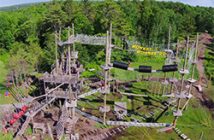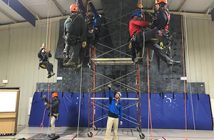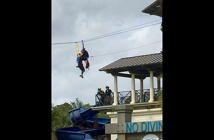No matter how user-friendly your equipment, or how efficient your park operation manages to be, you will need to evacuate a guest at height eventually. Whether it’s a guest whose momentum didn’t carry her through the belly of the zip line or a full-blown medical emergency, you must be prepared to act.
As with any negative situation your park faces, having a plan in place and the right equipment on hand—well maintained and with staff fully educated in its effective use—is critical.
Have a Plan
The first and most important step is to develop a plan for every imaginable scenario involving evacuation at height. You can’t train, practice, and ultimately react properly when something happens without a plan in place first.
Keep in mind, plans and standard practices must be instituted and updated by the course operator. Usually, zip line and aerial course manufacturers provide the initial training and equipment with their new installations. Check with your manufacturer about any updates, such as a list of approved rescue equipment, techniques, and other advice.
There exist no common, industry-wide standardized practices for rescue for particular situations, for the simple reason that “every course is different,” says Matt Andrews, climbing market sales manager at Sterling Ropes. “There’s no real standard way that someone would rescue somebody, mostly because each course is different, each element is unique, and each organization has its own standards and practices.”
For example, Terra Nova provides customers of its unique dynamic trolley systems with a ZipTour Guide Trolley that’s designed for use in zip line rescue and inspections. “We supply two of these along with two rescue kits with all of our ZipTour and ZipRider zip line rides,” says Terra Nova owner Eric Cylvick.
OSHA requires operators to have an emergency rescue and evacuation plan in place for employees. The same legal obligation doesn’t always apply to having such plans for guests, but the plans you develop should apply to all.
Once plans are developed and evacuation tools are in-hand, exhaustive training is next—but that’s a whole other discussion for another time.
Situational Assessment
OK, your plans are in place and the staff is thoroughly trained. And now, a guest is stuck.
When a guest becomes stuck or otherwise immobile in your park or zip line, you must first assess if the evacuee is in immediate medical or physical danger and requires emergency rescue. This assessment will then trigger a certain response. Even in less urgent situations, the potential for danger still exists: it doesn’t take long hanging immobile in a harness for suspension trauma—or orthostatic intolerance—to set in. So, no matter the circumstance, rapid and efficient rescue is the first priority.
After determining the level of immediate danger and need of medical assistance, attending staff must then assess the logistics of evacuating the guest from height. Each situation will call for a certain set of tools the guide or rescuer can use to safely remove a guest, but the common evacuation methods remain basically the same: load transfer and lowering, or moving a guest down to the end of the line if stuck.
On a zip line, the first consideration that determines what equipment to use is whether or not a situation requires shifting the guest’s weight off his or her existing trolley, i.e., a load transfer. “It’s all about transferring the weight from whatever system they’re connected to, onto a new system, and then lowering them or raising them as needed,” says Cliff Kirk, founder of Vertical Axcess. A load transfer is typically necessary when the trolley no longer functions correctly, or when the guest cannot reach or operate it on their own due to the length of the lanyard connected to the device, or if unconscious or injured.
Haul Kits
Lifting and suspending the entire weight of a guest while dangling from a zip line usually requires a tool that multiplies the guide’s strength enough to do so. A load transfer, also known as a pickoff, can be done using a haul kit.
One such kit is Petzl’s JAG system. “With a meter of 4:1 mechanical advantage, this can be done by one person fairly easily,” says Petzl America professional division manager Michel Goulet. With the top and bottom of the JAG system anchored with locking carabiners to the zip line and a descender device, once the rescuer lifts the evacuee enough to relieve tension, he or she can disconnect the evacuee from the trolley system and attach him or her to a new trolley, or to the descender to lower the guest to the ground.

The JAG comes in several lengths: one meter, two meters, or five meters at full deployment, which collapses down to .32, .34, and .4 meters, respectively. The hauling components in the JAG system are covered with a “sock,” Goulet says, that helps prevent entanglement. “It keeps the pulleys and the rope within the hauling system from getting crossed or mixed up.”
Sterling Ropes Raise and Rescue Elite Kit works in a similar fashion. Its 4:1 mechanical advantage haul kit allows guides to efficiently raise evacuees off a lanyard, even when only a few inches are all that’s needed to transfer the weight. This kit includes Sterling’s mini haul system, two wire slings, 19” HollowBlock2 (a friction hitch used as a prusik connecting the haul kit to the anchor), and two Osprey autolock carabiners. “Sometimes it’s only a matter of six or eight inches just to release the tension in that primary connection point and be able to hook them into something else,” Andrews says.
Once this load transfer is complete, the guide works to lower the evacuee to the ground safely, using a number of possible descender tools.
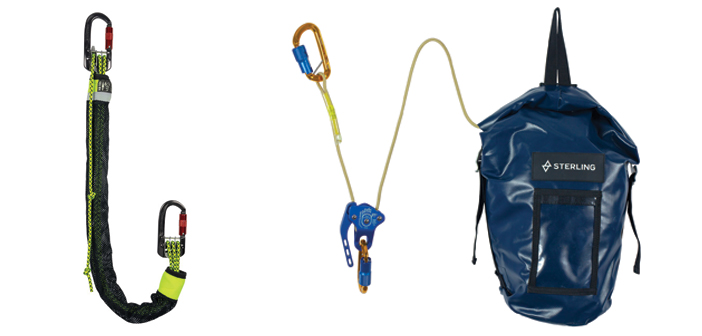
Descenders
In most cases where a load transfer is called for—when the trolley becomes stuck or inoperable to the guest, for example—lowering the guest to the ground covers most rescue scenarios. Haul systems like Petzl’s JAG system, Goulet says, “are designed to take someone off of their lanyard… and place that person’s weight from the lanyard to a lowering system.”
After the evacuee’s weight is shifted off the trolley system, the rescuer will clip the evacuee’s harness to a lowering system. Most lowering systems include static or low-stretch ropes, such as Sterling Ropes’ SuperStatic2 static lines or Petzl’s AXIS low stretch kernmantle rope, and a self-braking descender anchored to the zip line. These combinations allow the guide to lower a guest to the ground safely from an anchor point with minimized risk of the guest falling or descending too quickly, thanks to the systems’ anti-panic functions.
A number of descenders of this type exist on the market, including the Petzl I’D S, a self-braking descender with an anti-panic function and screwplate that allows the device to be more permanently integrated into a rescue kit. ISC Wales’ product, the D4 Work Rescue Descender, includes a panic brake as well as a set of audible clicks when the handle is rotated, making precise control of descent easier.
The MARK Elephant Hub functions similarly to these other descenders, but also acts as a haul kit: instead of pulling a cord to unweight the guest’s lanyard, a wheel is turned to allow for the load transfer and then safe descent of the guest, all in one device.
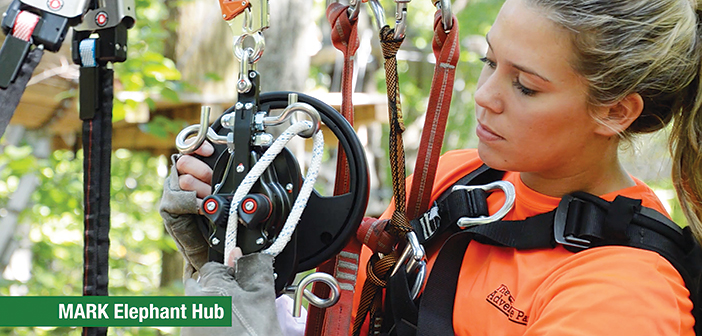
Ropes Course Evacuation
For adventure parks, lowering often takes place at different elements in a ropes course, such as a platform or ledge. In these cases, a guest might be too frightened to continue, or perhaps a storm is coming in, forcing the evacuation of many guests. Tools that can be anchored at a platform are effective for these types of evacuations.
According to Bahman Azarm, president and CEO of Outdoor Ventures, if evacuation is called for due to incoming weather, guests will often make their way back to the beginning or get to the end of the course if they’re only three or so elements away from either end. “It’s only that center portion of it, depending on how long the whole course is, that you’d then have those people come down from where they are in a controlled manner,” says Azarm.
This type of evacuation requires devices that allow for controlled descent from platforms, such as the Head Rush Technologies TruBlue auto belay. Another option is the MARK DescendAll, which has two alternating connections: when one guest is going down, the other connection comes up, so the next guest can clip in rather than wait for a single connection to return up. These are operated from a permanently installed anchor point.
“Many times we’ll put one at the end of a course for people to connect to from a 30- or 40-foot platform and come down,” says Azarm. In this type of course, the evac tool also functions as a possible termination of the course, giving guests an exit at any time they need.
Zip Line Belly Rescues
One scenario that pops up for smaller folks, especially children, when using a traditional zip line, is getting stuck in the belly, or low point, of the zip line because they’re too small for their momentum to carry them through to the end. This type of scenario is fairly common for older zip lines.
“The more traditional-style zip lines with large bellies in them, especially long ones, create more scenarios that you could encounter,” says Terra Nova’s Cylvick, such as very large spans that would require hundreds of feet of rope to be pulled to haul someone out rather than lowering them to the ground.
These rescues can require guides to move hand over hand up the zip line to get into the belly, using a tandem trolley, transfer the guest’s load onto their system, and pull them back out to the end platform using a rope they’ve trailed behind them.
Fortunately, much of the equipment for these basic load-transfer and lower evacuation scenarios are sold in kits, like Petzl’s JAG Rescue Kit, which in addition to the JAG system includes a Connexion Fixe 150 cm anchor strap, a Ring Open gated ring, an I’D S descender, an Axis 11 mm rope, and a haul bag for the rope.
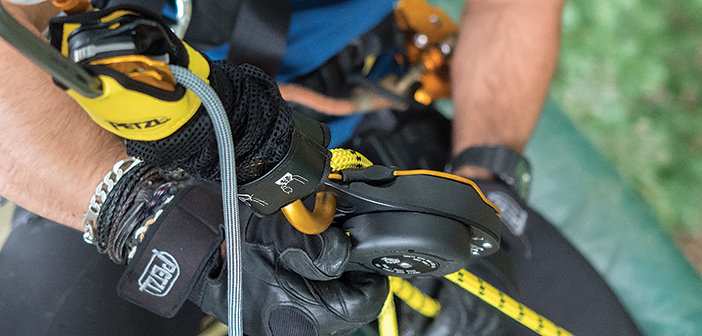
Brands like Petzl, according to Goulet, saw the need for such a kit as they learned more about the people doing the rescuing in most situations. “These are not paid rescue professionals,“ Goulet says, “so they don’t get into these situations very often, though the responsibility falls squarely on their shoulders to be able to respond in a timely manner so that the person can be [rescued rapidly].”
Usually it’s the guides, not trained rescue teams, who get guests off the zip line, and these kits make it easier for operators to ensure their staff are ready to evacuate or rescue a guest from a line rapidly enough to prevent any sort of suspension trauma or discomfort. Outside of the rescue kits and haul/lowering systems, guides might want to carry a knife or tool that allows them to deal with and remove entanglements, such as a lock of hair or clothing item jammed in a trolley.
Each park is unique, and the best tools a park operator can acquire are regular staff training in the unique situations that may crop up, a meticulously defined procedure tailored for those situations, and the basic systems for lowering, hauling, and load transfer.




